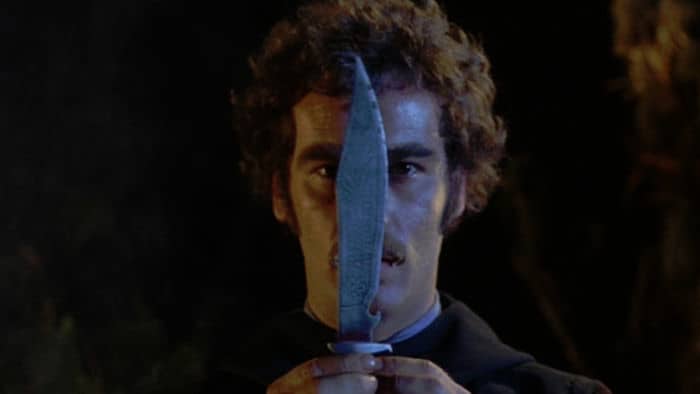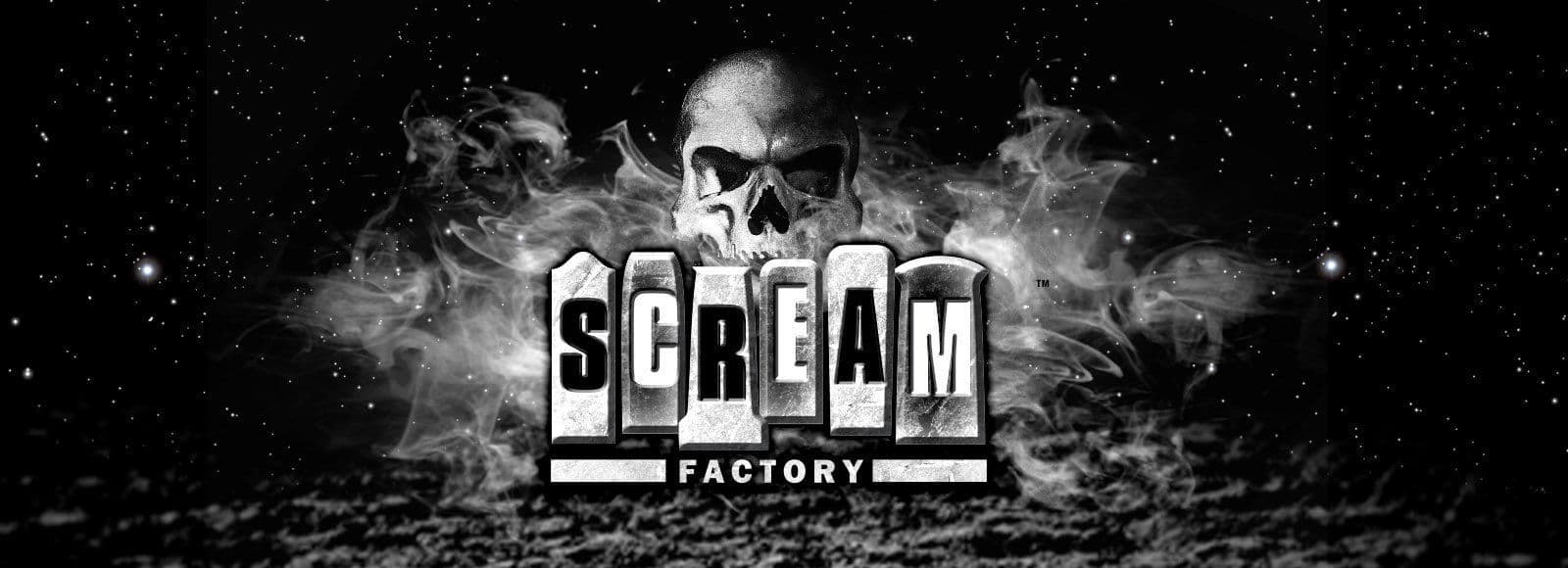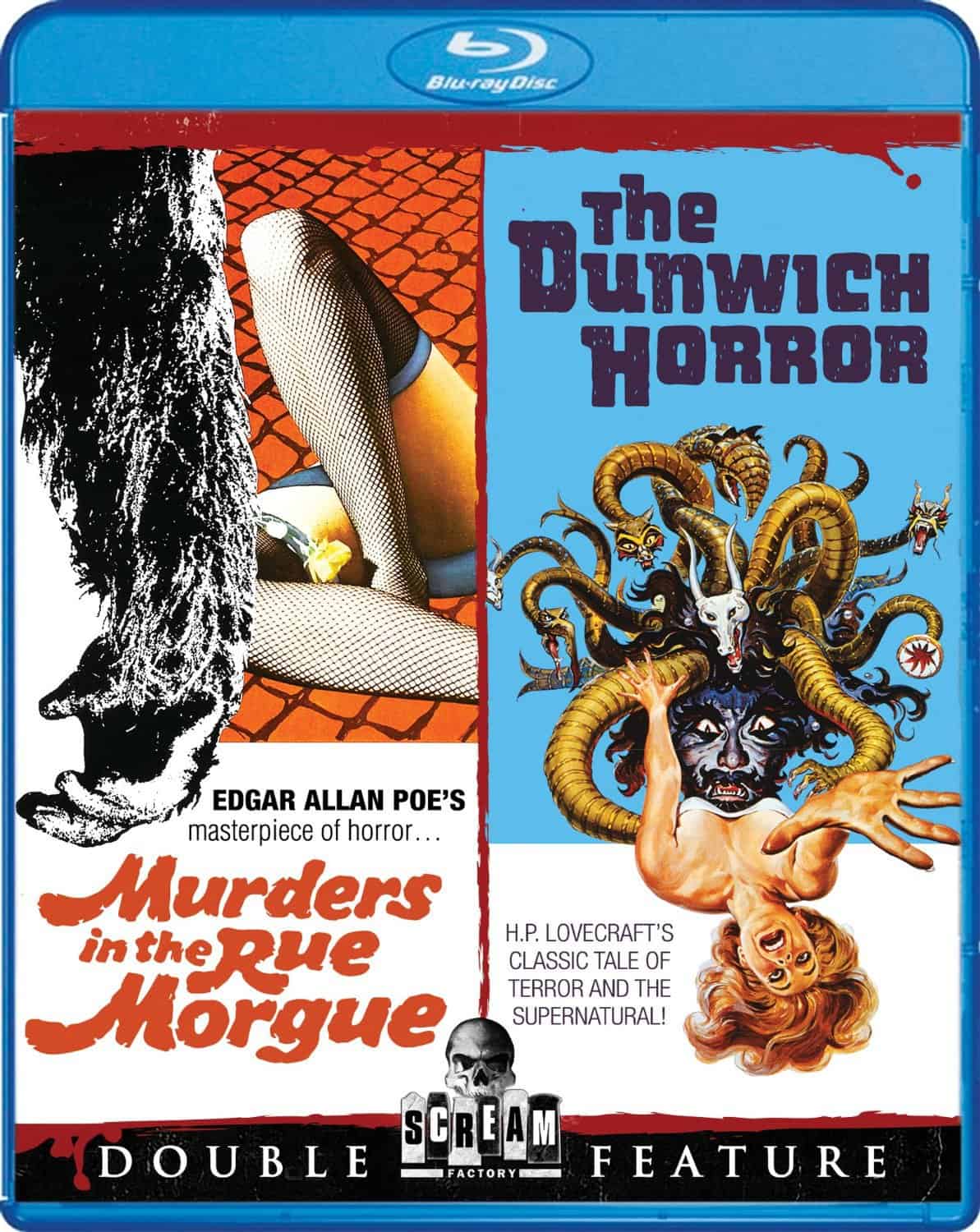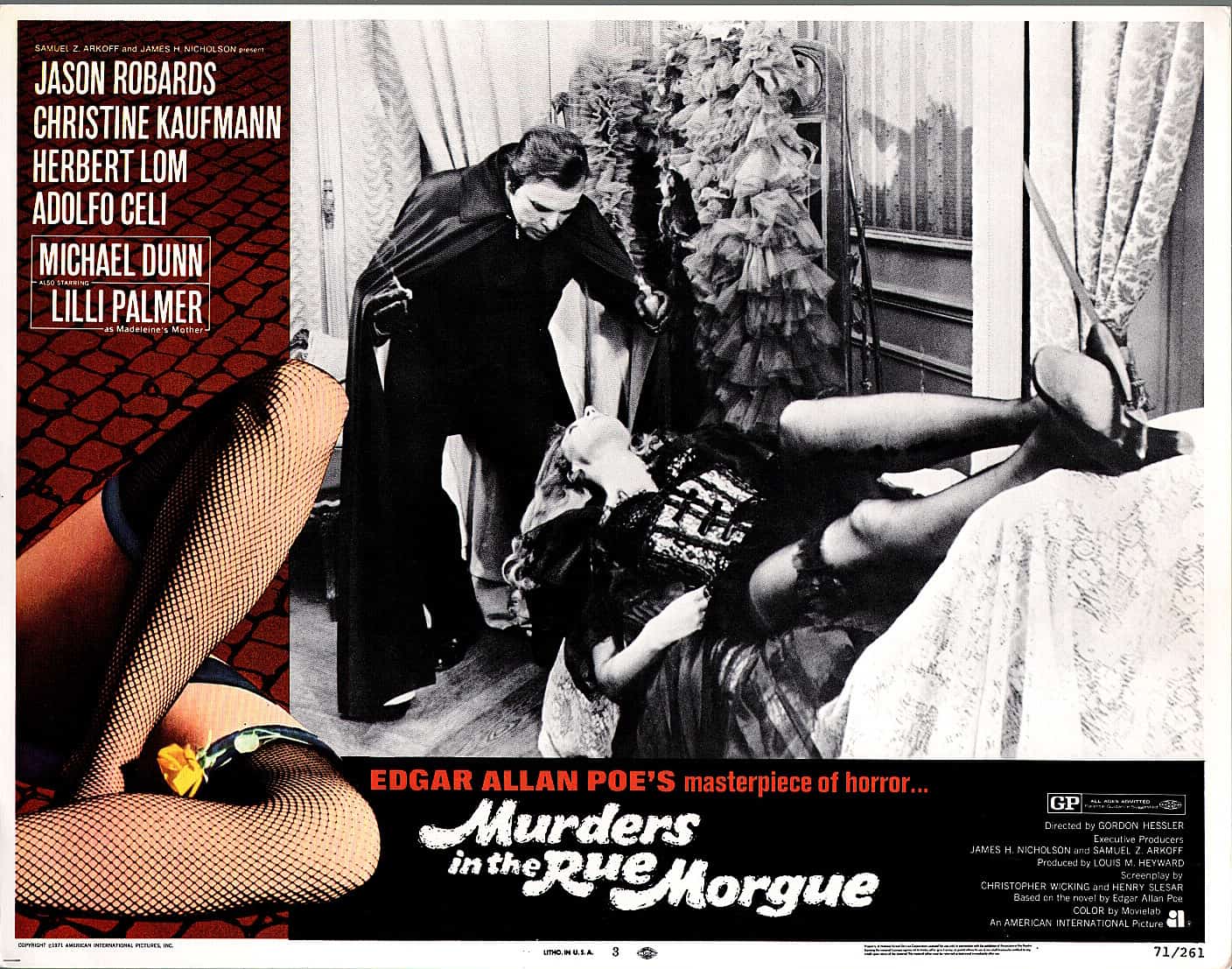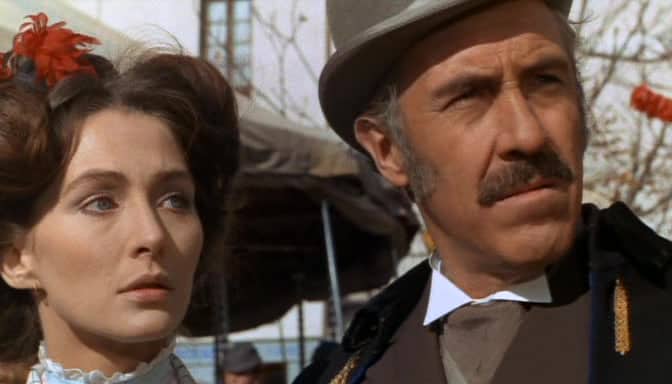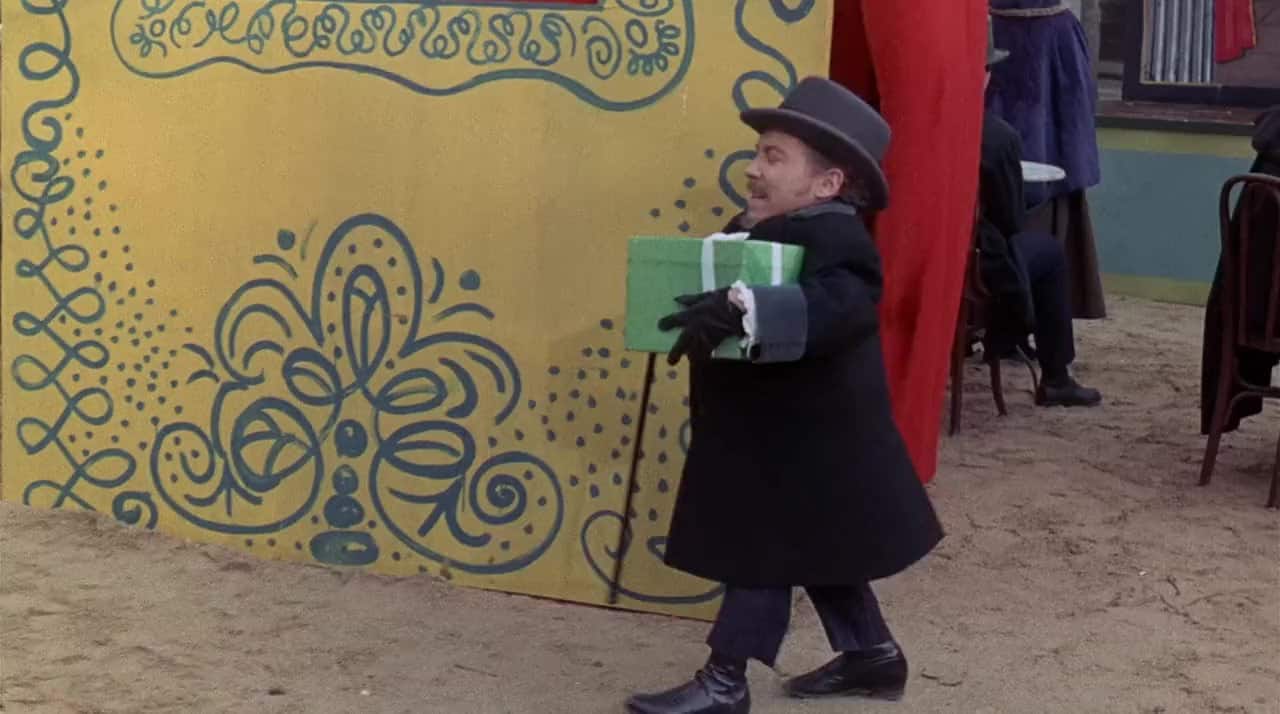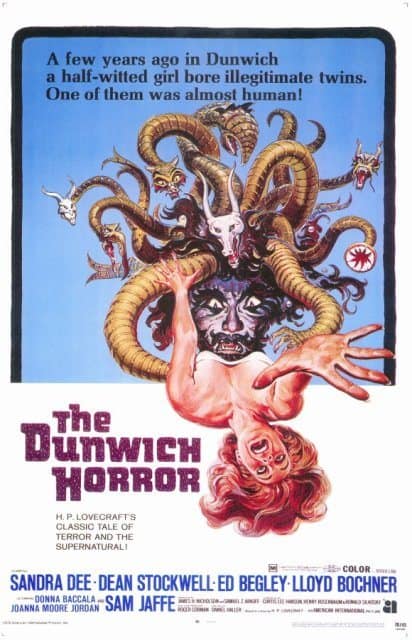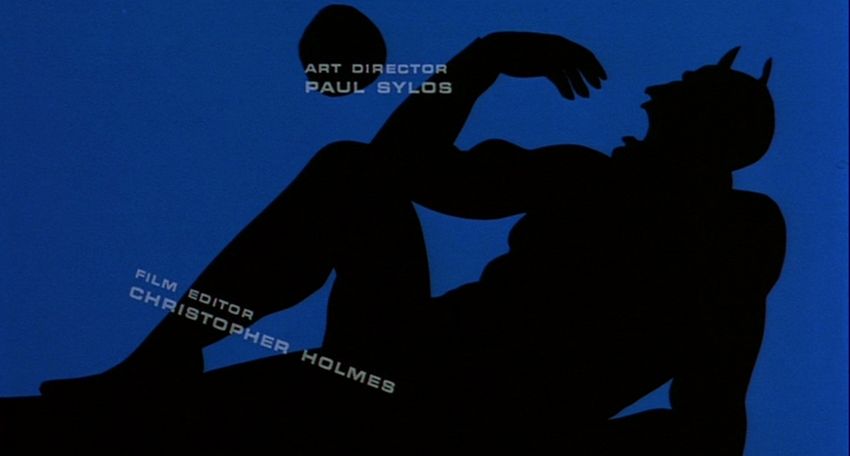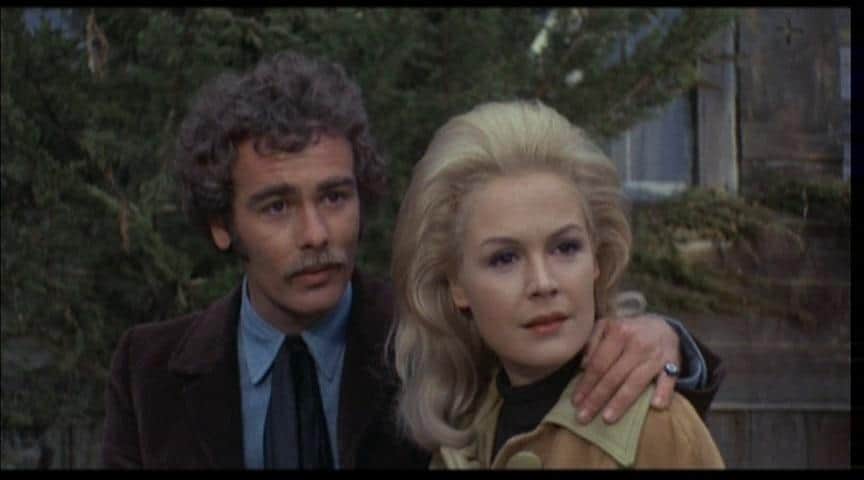Welcome to another Scream Factory blu-ray release, this time for the double-feature of Murders in the Rue Morgue and The Dunwich Horror. Both were produced by the now long defunct American International Pictures studio and are adaptations of the works of famous authors, Edgar Allan Poe for the former, and H.P. Lovecraft for the latter. The blu-ray was released on March 29th, 2016.
Packaging
Arriving in a standard amaray blu-ray case, the front side of the paper slip is graced with the original poster artwork of both films. The films are housed on a single blu-ray disc and each side of the interior case sports images from the movies. As with all Scream Factory double-feature discs, once the company logos have played, viewers are greeted by a screen at which they select the film they wish to watch.
Feature Presentations
Written by Christopher Wicking and Henry Slesar
Directed by Gordon Hessler
U.S.A., 1971
In this very, very loose adaptation of Edgar Allan Poe’s classic murder mystery yarn (often described as the original murder mystery novel), viewers are transported to early 20th Century Paris where theatre director and leading man Cesar Charron (Jason Robards) is putting on a production of Murders in the Rue Morgue. The story is one of romance gone awry, deceit, torture and murder, and even includes an ape, much like how Poe’s original oeuvre featured an orangutan. His wife, the young Madeleine (Christine Kaufmann), is having terrible, confusing nightmares about things that may have transpired in the distant past, or possibly things that are to come. Soon, the bodies of Charron’s acting troupe keep turning up, putting inspector Vidocq (Adolfo Celi) on the scent. Clues seem to be pointing towards the impossible: a long-dead theatre colleague of Charron’s, Rene Marot (Herbert Lom), who committed suicide following a grotesque disfigurement. Has he somehow risen from the grave?
Anyone familiar with American International Pictures (AIP for short), knows that their outings were low budget affairs that dabbled in racy plots with violence, action, and a little bit of sex. They sports a distinctive style steeped in early 1970s filmmaking, and while the lower-budgets with which its filmmakers worked is often cited as a major influential element, the fact of the matter is, at least as far as this release’s two films are concerned, the artists behind the camera pulled off quite a bit with little. Murders in the Rue Morgue, which was actually filmed in Spain, is one such example, by which the sets and costume design are in actuality among the film’s impressive qualities, in some ways masking as much as they can the modest means available to produce the endeavor.
Also apparent with many independently minded studio filmmaking projects that embraces the horror-thriller genre, director Gordon Hessler’s picture is unafraid to embellish of the more salacious and horrific story elements, occasionally resorting to techniques that definitely verge on the art-house side of the spectrum. Christine’s dreams play out like fever dreams, to say nothing of the fact that the movie opens with one about 30 seconds after the first shot, but without making it explicit that she is experiencing a dream. As such, the movie has a fantastical quality about it, rarely holding the viewers hand. Gordon Hessler deserves a lot of credit for a confident directorial style that helps set the mood and tone, with an impressive number of shots that go on for elongated periods of time instead being chopped up in the editing bay. Apart from the occasionally obvious limitations in the lighting being used, the film looks rather solid on the whole.
The cast is a bit of a mixed bag, with Jason Robards strangely being one of the weaker links. While not bad per say, there are scenes in which his acting feels out of place, and out of synch with that of his co-stars. Many of the actors, such as Herbert Lom and Adolfo Celi, come off as relaxed in their roles, whereas Robards wants to ham things up more than necessary. Kaufmann is predominantly reduced to looking petrified or very surprised, making a bit difficult to gauge her talents in the film, but she delivers what is asked of her at the very least.
As for the story, Murders in the Rue Morgue has no fear about going all over the place. The backstory that set up the present-day murders is replete with some eerie sexual tension (Charron falling in love with a girl he met when she was but a child is but one of the bizarre details that drive the plot), and director Hessler regularly gets the ball rolling again whenever it seems as though proceedings are about to wind down, which actually falls in line nicely with the overarching theme about it being impossible to rid one’s self of the past. Just when it appears as though order has been restored, evil keeps rearing its ugly head.
Written by Curtis Hanson and Henry Rosenbaum
Directed by Daniel Haller
U.S.A., 1970
A slightly more faithful adaptation of a classic horror novel than is Murders in the Rue Morgue, The Dunwich Horror follows the adventures of two disparate sides of the moral compass. One the hand is Dr. Henry Armitrage (Ed Begley), professor at a local university currently doing lectures on the Necronomicon, a book about ancient evils, the title of which will certainly have the ears of Evil Dead fans perk up. On the other is Wilbur Whateley (Dean Stockell), a visitor to the university with an interest in the same book, but refrains from making his intentions perfectly clear. Dr. Armitrage refuses to lend the book, fearful of its grave potential. In the process of his brief séjour, Wilbur seduces one of Armitrage’s students, Nancy Wagner (Sandra Dee), getting her to drive him back to his nearby, ancient home and stay with him for the weekend. Little does Nancy know that Wilbur is the great-grandson of a man who tried to open a portal between Earth and a world of monsters. His grandfather (Sam Jaffe) also tried but failed. Now Wilbur will try to do the same with Nancy, whose virginal qualities he needs to call upon a great evil during a cultish ceremony.
The Dunwich Horror operates on its own deliberate pace. It is much less the sort of film that seeks to shock an audience with a series of jump scares despite the presence of one or two, but rather one that aims to unsettle. For that reason, viewers hoping for a crazy misadventure in which Lovecraftian creatures run amuck, spreading terror everywhere, might want to keep their expectations in check. What director Haller and his cast have in store is a slow burn thriller that is more a race against time than it is a monster flick, although, rest assured, there is a beast that makes an appearance in the latter stages.
One of the neatest features is how the filmmakers obstinately attempt to make the film as artistic as possible. Whenever a character suffers a terrible fate or a strange being lurks about, the action is often captured from their point of view, and the image itself is drenched in primary colours that continuously change. The technique will undoubtedly come across as cheap to modern viewers, but for anyone willing to buy into what the filmmakers are angling for, the experiment is worthwhile. This being an AIP project, it goes without saying it was realized on modest means, so gigantic special effects pieces were out of the question. The result is a film that plays its cards in a fashion that at times clearly suggests that limited resources are being camouflaged, but that also add a curiously adventurous flavour to the story.
Special mention need go to Ed Begley, who acted for the final time in The Dunwich Horror. A heart attack sadly took him away only months after the theatrical release. He gives a lively, convincing performance for director Haller as the driven Dr. Armitrage, striving for avoid the worst case scenario that his nemesis Wilbur dreams about. Another aspect worthy of special notice is the score, courtesy of composer Les Baxter. A haunting yet oddly catchy tune, the main theme plays regularly throughout the film, sometimes arranged in different manners depending on what the mood of the scene at hand is. Purchasers of the blu-ray disc get a taste right off the bat as it plays during the film’s menu screen. Finally, the opening title sequence, an animated sequence created by Sandy Dvore. Capturing the plight of a man and a woman, depicted as black silhouettes against a blue background, as they run away from and fight against odd beasts, is one of the highlights of the entire film.
Video and audio
Both films are presented in 1080p 1.78:1 high definition, with the results something of a mixed bag. In fairness, the overall picture quality, especially for sequences that occur indoors in controlled environments like sets, is solid. There are several of moments when the colours really pop off the screen, which is of particular importance in these two films. Rue Morgue is decorated with a great many impressive costumes and sets whereas Dunwich sports very adventurous, psychedelic colours schemes, be it via post-production effects or the wonderful cinematography handled by Richard Glouner. It should be noted that, in many instances, the image quality if very clean as well, making it look as if the films were been made far more recently than is actually the case.
That said, there are more than a few moments when very visible pops and morsels of debris can be spotted. For instance, a scene will fade to black and the upper corner a big white spot will show up for a split second. It wouldn’t be so distracting if the damage did not present itself in such large, conspicuous chunks. As it stands, the transfers generally look handsome, but said quality is interrupted by extremely glaring debris. Scream Factory are not the biggest DVD and blu-ray production company, so one can understand that they probably have to pick and choose which of their releases will go through remastering processes, although it would have been nice had a little bit of work had been done about the glaring dirt.
The DTS-HD Master Audio Mono tracks are both decent, but it clear that they support sound effects and music more than they do the dialogue. The scores in both films sound amazing, and whenever anybody screams or synthetic sound affects erupt, they come through the speakers loud and clear. While dialogue is not necessarily difficult to understand, it does sound just a bit soft at time, something that is more noticeable in Dunwich than it is in Rue Morgue.
Supplements
In a pleasant surprise, this is a Scream Factory double-feature that has not one but two brand new audio commentaries with film historian Steve Haberman as their host. Haberman’s voice strongly hints that he is very enthusiastic about both pictures, which is always great whenever listening to commentaries. What’s more, his insights and knowledge are quite widespread, so listeners are sure to learn a thing or two about the topics at hand. The only issue with which one might take any umbrage is that that Haberman actually talks more about the background of the individuals involved than the films themselves. Personal histories of cast and crew, previous projects, tangentially or directly related artists and their works that influenced Rue Morgue and Dunwich, there’s no shortage of information, much of it very interesting, only that is rarely pertains to the actual scenes playing out.
A vintage interview with Rue Morgue director Gordon Hessler is also available.
Final Scream
Both for the quality of the films and the supplemental material, this is one of Scream Factory’s better double-bills. While whether the two films can be described as classy is open to debate, they do have a handful of artistic touches that help distinguish them from a lot of what Scream Factory tends to release, to say nothing of the fact that the studio rarely goes as far back as the early 1970s when selecting their movies. Because of that, the blu-ray earns a confident recommendation.
-Edgar Chaput


